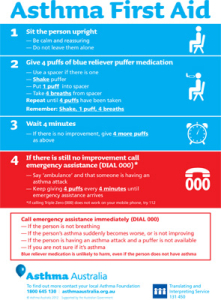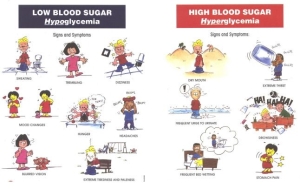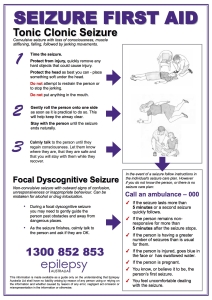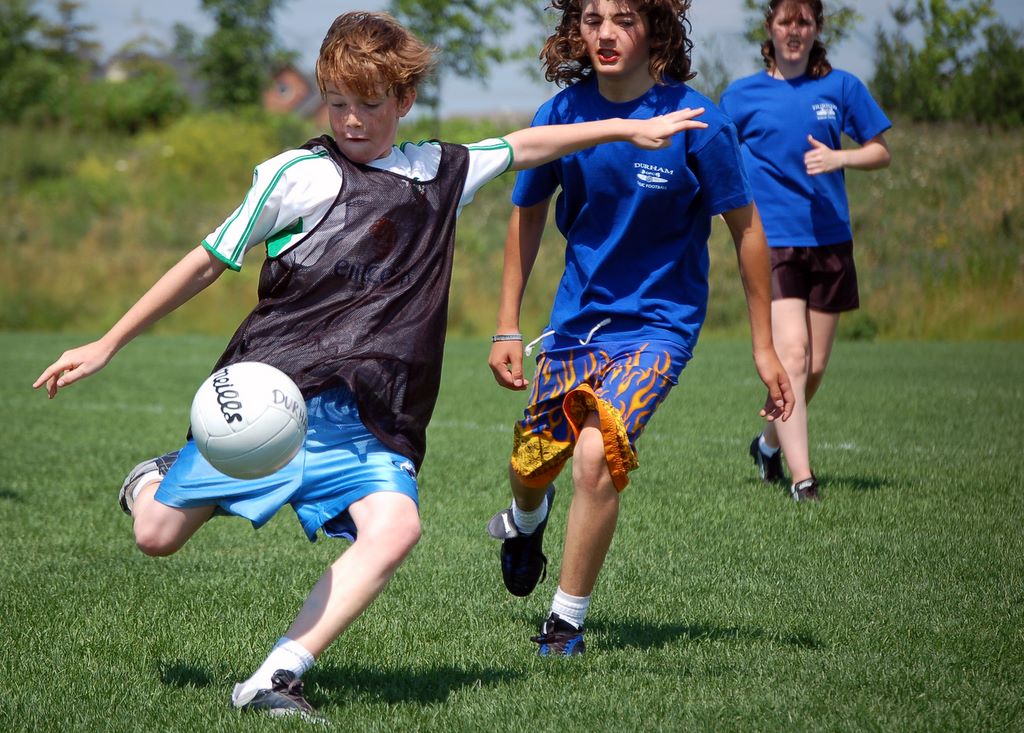Children and young athletes can have a variety of medical conditions. The focus for HSC PDHPE is on asthma, diabetes and epilepsy. Of particular importance are the implications of each of these medical conditions for the ways young people engage in sport and how each medical condition is managed.
Asthma – Medical Condition
Asthma is a medical condition that affects the airways. Asthma is characterised by inflammation of the airways leading to contraction of the bronchioles (airway branches) limiting the air flow both into and out of the lungs. The medical condition, asthma, has various possible triggers including: dust, pollen, pollution and exercise.
Implications of asthma for the ways children and young people engage in sport
The medical condition of asthma can be induced by exercise, and is more likely to be triggers in longer duration physical activity than short and intense bursts of activity. This means exercise induced asthma is more likely to occur during a marathon run, than a 100m sprint. However, it is important to know that the asthma “attack” is usually proportional to the intensity of the exercise. Having asthma should not stop a child or young person from participating in sport, but there are actions that should be in place to manage this medical condition.
 How asthma is managed
How asthma is managed
All children and young athletes, who have asthma as a medical condition, should have an Asthma Management Plan developed with their GP. This Asthma Management Plan should be provided to those supervising the physical activity for their knowledge and use if and when necessary. In addition to this, children and young athletes with this medical condition should also have a ventolin puffer (usually blue or grey) with them for use if an asthma “attack” occurs. The supervising adult should also know how to address an Asthma “attack” through First Aid training. Furthermore, exercise induced asthma can possibly be prevented through a proper warm-up and cool-down.
For further information on the management of asthma see here.
Diabetes – Medical Condition
Diabetes is another medical condition frequently found in children and young athletes. There are two (2) types of diabetes. Type two (2) diabetes, is a medication condition caused by lifestyle, often brought on through physical inactivity and poor diet. It is characterised by a breakdown in the efficiency of insulin activity resulting in high levels of insulin (which is responsible for the transport of glucose from the blood into our tissue cells) and glucose in the blood. Type one (1) diabetes is also known as insulin dependant and early onset diabetes, is a medical condition caused by an autoimmune disorder. Type one (1) diabetes is when the body no longer produces insulin resulting in a build up of glucose in the blood. Type one (1) diabetes is the medical condition more prevalent amongst children and young athletes.
Implications of Diabetes for the ways children and young people engage in sport
Diabetes is a medical condition that relates to the glucose levels in blood, which affects sports engagement because glucose is also an important energy source for ATP production during sport participation. As a child or young athlete participates in sport, their muscle cells are opened for glucose transport without the need for insulin. This results in a decrease in blood glucose, which can become problematic for children and young athletes who have diabetes. If glucose levels are too low it can lead to a hypoglycaemic episode, but if they are too high it can cause a hyperglycaemic episode. Both of these can lead to loss of consciousness and death. It is, therefore, important that children and young athletes who have diabetes as a medical condition monitor their blood glucose levels closely, which normally means not having an insulin injection before or after sport, and eating meals before and after exercise to help balance blood glucose levels.
How diabetes is managed
Diabetes is often managed through insulin injections and access to sugary foods. Children and young athletes who have this medical condition should participate in regular physical activity as it helps manage both types of diabetes and can prevent hyperglycaemia. Children and young athletes with diabetes should have access to food to sugary drinks during physical activity and seek to eat before and after sports events. It is important for those supervising children and young athletes who have diabetes to know the first aid procedures used to manage hyper- and hypo-glycaemic episodes.
 Hypoglycaemic episodes have a sudden onset and cause: rapid heart rate, sweating, shaking, anxiety, dizziness and unconsciousness. It is managed by providing sugary foods or drinks, such as: jelly beans or juice. Further food should then be consumed afterwards.
Hypoglycaemic episodes have a sudden onset and cause: rapid heart rate, sweating, shaking, anxiety, dizziness and unconsciousness. It is managed by providing sugary foods or drinks, such as: jelly beans or juice. Further food should then be consumed afterwards.
Hyperglycaemic episodes occur slowly and may cause: thirst, vomiting, weak rapid pulse, rapid breathing and drowsiness. Medical assistance should be sought in the treatment of hyperglycaemic episodes.
For more information on diabetes as a medical condition affecting children and young athletes see here.
Epilepsy – Medical Condition
Epilepsy is used to refer to a group of medical condition relating to disruption of normal brain activity that results in seizures. A seizure is when the brains nerve cells misfire and generate sudden, uncontrolled burst of electrical activity in the brain. The orderly communication between nerve cells becomes scrambled and our thoughts, feelings or movements become momentarily confused or uncontrolled. Epileptic seizures can be subtle with only momentary loss of consciousness, or conspicuous causing sudden loss of body control. Epilepsy is unpredictable and often scary to those involved and observing.
 Implications of Epilepsy for the ways children and young people engage in sport
Implications of Epilepsy for the ways children and young people engage in sport
Epilepsy is a medical condition that should not stop children and young athletes from participating in sport. There are many medications that can be used to reduce the likelihood of seizures occurring. Epilepsy should not limit sport choice for children and young athletes, but the type and possible triggers should be considered as sports are selected. Children and young athletes who have epilepsy should ensure others a present as they participate in sports, particularly activities such as: water sports, bike and horse riding.
How epilepsy is managed
Epilepsy can be managed through medication, but the supervising adult should be aware of how to manage seizures, in case they occur.
Further reading on epilepsy as a medical condition affecting children and young athletes can be found here.

